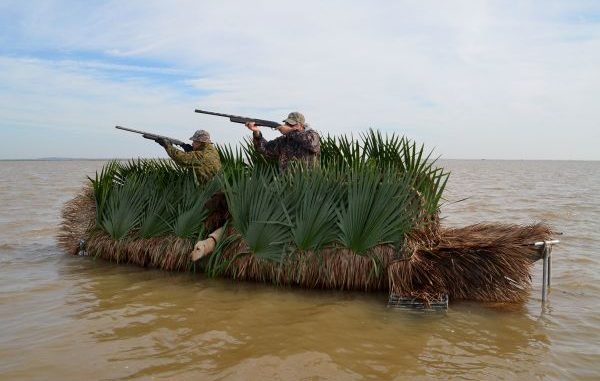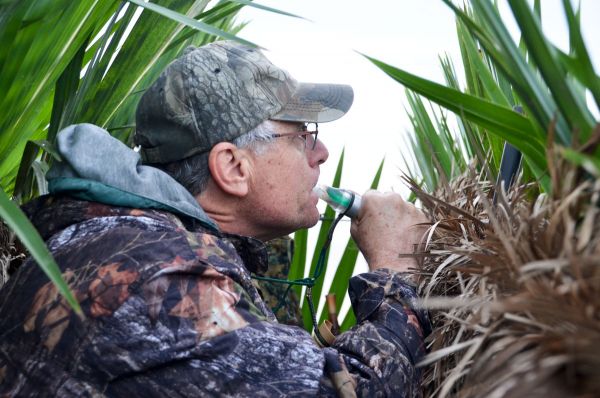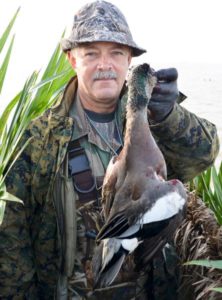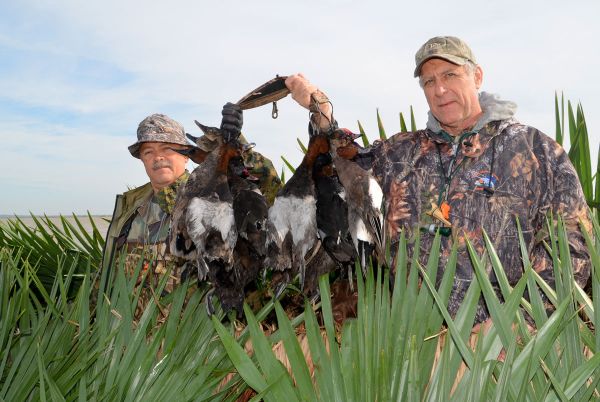
A willingness to leave those fixed blinds goes a long way to filling the duck strap — especially when birds start avoiding those regular setups.
This is the tale of three duck hunters: Edison, MacGyver and Fatso.
The first two really liked to kill ducks and were determined to find a better way to do it.
Pat Attaway plays Edison here — Thomas Alva Edison, America’s greatest inventor, the holder of 1,093 U.S. patents. Like the real life Edison, Attaway’s mind never stops organizing and churning out ideas.
Secret agent Angus MacGyver was the fictional star in the 1985 to 1992 TV show, named naturally enough, MacGyver. His claim to fame was the ability to solve complex problems under harrowing conditions with everyday materials and his main tools: duct tape and a Swiss Army knife.
MacGyver, in this drama, stars John Dupuis, an ever-resourceful fix-it guy who is never baffled by any problem and can make anything work.
As for Fatso — well, let’s just say that he’s an old, over-the-hill duck hunter who has good intentions. He is played by an equally old outdoor writer who loves good food.
Attaway and Dupuis hunt public land. Their ducks are heavily pressured and wary. Making things worse, the wildlife management area has large areas of open water without a stitch of cover.
But they kill ducks — lots of ducks.
How do they do it?
They use a pop-up boat blind, not often considered to be the best duck-hunting setup. Many duck hunters just flat out say they don’t work.
Others show that old habits are hard to break; they build a brush blind and drive their boat into the blind before popping the sides up. It sounds humorous, but it often happens.

Attaway (the inventor) and Dupuis (the tinkerer) do neither, and they most often hunt in wide-open water — places where it is impossible to even nest the blind-bearing boat near a bank to partly camouflage it.
But neither do they hunt with an out-of-the-box, factory-rigged, pop up blind boat — far from it.
Before we get ahead of ourselves, the story of how they got to the point of being dedicated pop-up artists is telling. Attaway, now 54, started his duck hunting at age 14, walking into the marshes of Pecan Island and later Weeks Island. During a military stint in Virginia, he hunted from a homemade boat blind in the Little Neck River.
After the military and back in Lafayette, Attaway began hunting public lands, slogging through the mud and squatting in water hyacinths. He stepped up a notch when he learned to build blinds with wax myrtle.
While the blinds were effective, he found they had a number of drawbacks. He had to constantly cut boat loads of the brush and haul them to his hunting spot. Low water after strong cold fronts would leave his blind high and dry.
And he found that he could never depend on his wax myrtle being there. Bad weather between hunts would damage or even flatten his blind. Building a permanent frame-blind on a public area was illegal, so that was out of the question.
“I needed a more efficient way to hunt,” he said. “I tried to make portable blinds with plywood for the floor, PVC pipes for the frame, fish-net webbing for the sides and palmetto fronds. But mobility was a drawback. I had to pick everything up and set it back out every day.
“Then I had the opportunity to hunt from a boat with a pop-up blind. One hunt and I was sold.”
Dupuis, at 51, is slightly younger than Attaway and didn’t forsake deer hunting for duck hunting until his late 20s. For 10 years he walked into Atchafalaya Basin swamps near his home in Breaux Bridge and hunted by standing next to trees — no blind at all.
Then, in 1998, he was invited by a mutual friend to hunt with Attaway during Attaway’s wax myrtle blind period.
The pair began hunting together regularly and cobbled together a homemade boat blind made of camouflage-painted canvas that mounted on their outboard-propelled boat.
It didn’t work well.
“I had a hard time accepting boat blinds,” Dupuis said. “I had poor success from make-shift blinds — that is, until I tried a pop-up blind with grass mats.
“I found comfort, mobility and success.”
Five years ago, the pair partnered in the purchase of a second-hand 18-foot Gator Trax shallow-water boat powered by a long-shaft mud motor. They quickly replaced the motor with a more-modern 35-horsepower Pro-Drive surface drive mud motor, but clung to the original hull because they loved its long, narrow profile.
Their success attracted the attention of Fatso, who dragged his old bones to their camp early this season season — right in the middle of the poorest Louisiana duck count in years.
When Fatso got to the camp on a bluebird day, he found the two heros of his story-to-be smugly grinning, ready to pose with their 12-bird limit.
They got off the water at 8:40 a.m.

The next day’s weather forecast promised more of the same — blue skies. Fatso went to bed dreaming of ducks dropping out of the sky into the decoys with their feet splayed. He didn’t need rousing the next morning.
The same ritual was taking place in duck camps across Louisiana: men stretching, grunting and scratching, coffee being slurped and shell buckets being checked one last time.
Well, before daylight the three men and their two Labrador retrievers — Dupuis’ yellow Belle and Attaway’s chocolate Skye — pulled away from the camp. The dogs’ owners were armed with 12-guage shotguns. Fatso carried a camera and note pad; he wanted to see this blind work.
The two hunters had obviously done the setup together often. Decoys were put out. Spuds were driven to stabilize the boat. The grass blind was folded up into shooting position. Grass mats were spread to hide the motor and bow.
Attaway produced handfuls of green palmetto fronds from a pile on the floor of the boat near the bow. They inserted the stems through the fish net-backed grass mats so the upper tips of the fronds provided cover for their faces.
Little was said; each knew his job.
By shooting time, the pair of hunters was ready for duty, with their guns loaded and Belle and Skye straining to look out of their “launching hole.”
They didn’t have long to wait.
A flight of a dozen or so canvasbacks came roaring across one end of the blind. A few quick blasts on a mallard call turned them in precision formation, almost like a flight of F-14 fighter planes, and they came in for a strafing run over the decoys.
Four blasts from the two shotguns dropped three gorgeous drakes into the decoys.
Attaway shook his head.
“Canvasbacks sure are stupid. It’s a wonder any of them are left alive after hunting season.”
Dupuis wasn’t disappointed, however.
“But they eat good!” he countered.
As Attaway pointed out, the cans weren’t a challenge to the effectiveness of their blind. Neither were the next few birds. A pair of scaup responded to the call and bee-lined for the decoys.
After hesitating, the men dropped them both.
Attaway, who was working the dogs in the center of the boat, alternated sending Skye and Belle on retrieves. Skye hadn’t even shaken dry yet when a pair of ringnecks came barreling in on the decoy spread.
Two shots; two more dead ducks.
Good shooting light spread over the water, and Fatso waited to see if ducks would begin to hesitate approaching the blind or, worse, flaring from it.
A flock of gadwalls passed in the distance. With their plastic sweet-talkers, Attaway and Dupuis easily pulled three off of the flock.
All three gullibly spread their feet to land. Three shots put two mature drakes on the water. No flaring here.

Next up were redheads. A flock of six at the edge of call range responded and, like the gadwalls, tried to land. Of course, the ace shooting couldn’t last. After five shots and a lot of laughing, Belle retrieved a lone russet-headed male.
A pair of ringnecks buzzed in. The girl flew away; the boy stayed.
The last duck taken to fill out the 12-bird limit was a widgeon, a favorite species of Attaway’s. The stunning drake was hand-picked out of a flock.
No ducks avoided the blind or flared.
Overnight the weather changed, and the next morning the hunters awakened to blistering 25-mph north winds, normally a challenging situation where Dupuis and Attaway hunt. They didn’t leave camp until after daylight because of the weather, so the hunt would begin late.
And Attaway set a 9 a.m. deadline on the hunt because of other obligations.
Making things tougher was the fact that there would be 18 birds to take. Fatso had exchanged his camera for a shotgun, and was champing at the bit.
They set up and waited, and waited, and waited. Twenty minutes and nothing. It looked bad.
Then a flock of green-winged teal materialized and tried to sit down in the decoys — katoom, katoom, katoom! Three down.
Before the birds could be retrieved, a lone redhead female committed suicide.
Immediately, she was followed by a huge flock of ducks that came directly out of the sun and jumped on the blind. Instinct took over; shoot first and ask questions later.
Three shots produced three dead ducks — all spoonies.
The action was amazing. None of the birds were shy about coming to the blind.
Two pintails, the wariest of ducks, circled in to the blind in response to the hunters’ quacks and peeps. One dropped instantly. The other was a delayed reaction and fell hundreds of yards away — a long retrieve.
Dupuis climbed out of the boat to better direct Belle. While he was preoccupied and Fatso was looking elsewhere, a giant flock of greenwings rushed the rear of the blind.
Attaway, who heard the wings (Fatso is half-deaf), popped off three fast shots and killed four of the little creatures.
Fourteen ducks — just like that.
After all the bodies were gathered, a big flock of widgeons passed in the distance. All three men leaned on their calls, and one lone sucker peeled off to investigate. He never left.
Then another green-winged teal fell.
Sixteen down and two to go. It was only 8:15 a.m.
It took 15 minutes to take the next bird. A flock of pintails passed the decoys, ignoring them with aplomb. One edged a bit closer in response to the calls, and a long shot (it had to be luck) by Fatso took it.
Twenty-five minutes and not a shot fired. With Attaway’s 9 a.m. deadline fast approaching, the hunters needed only one more bird to make the limit.
At the stroke of the hour, a flock of redheads approached dead-on to the boat blind. Dupuis, who had one bird to make, picked out a big one and let him have it.
The day was done.


